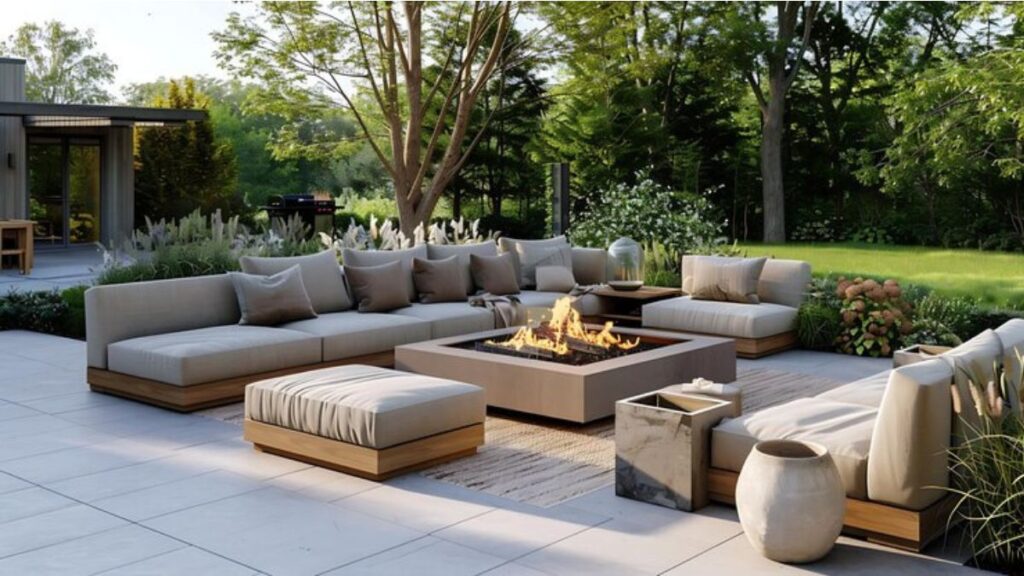Have you ever imagined transforming your outdoor space into a beautiful, eco-friendly oasis? Many of us spend a lot of time designing our indoor spaces, but the outdoors can be as important, especially when we think about sustainability.
What if we could create a living space that not only looks amazing but also helps the environment? This guide will show you how to design a green outdoor living area with energy-efficient lighting.
In this article, you’ll learn how to blend eco-consciousness with ambiance and functionality, using lighting and outdoor elements that are both beautiful and sustainable. Read on!
Why Sustainability Matters for Outdoor Spaces
Making an outdoor space that is good for the environment is more than just making it look nice. It’s about making decisions that are good for the environment.
Focusing on eco-friendly habits can help us use less energy, save water, and even lower our carbon footprint. Being sustainable doesn’t have to be hard or cost a lot of money.
Making little changes, like picking the right lighting or plants that don’t need much water, can have a big effect. Not only that, but designing with nature in mind will make your space more enjoyable and better for your health.
A sustainable approach helps us make better choices and feel more connected to the world around us. An outdoor living space with more plants will also make your home worth more, so it’s a good investment in the long run.
Start with Energy-Efficient Lighting
Getting the right lighting can make all the difference when making a green outdoor living space. Lighting that uses less energy is the first thing that can be done to make a space more eco-friendly.
A lot of people choose LED lights because they last longer and use less power than regular bulbs. Another great choice is solar-powered lights, which get their power from the sun and don’t need any wiring. These lights are great for making pathways brighter, drawing attention to plants, and making the area feel cozier.
You can also add motion sensor lights that will only turn on when they are needed and save energy. Smart outdoor lighting systems come with remote controls that let you change the settings to use the least amount of energy possible. When planning your lighting, think about where it will go and how much light each area needs so you don’t waste light and can focus on what’s important.
Choosing the Right Lighting Fixtures
Picking the right outdoor fixtures is important for making a space that works and is good for the environment. Choose fixtures that are made from eco-friendly or recycled materials, like stainless steel, aluminum, or recycled glass. These things not only last longer, but they also make less trash.
When choosing fixtures, make sure they are made to be used outside to make sure they are safe and will last a long time. Many stylish and up-to-date options can make your space look better without hurting the environment.
Pendant lights or fixtures that look like lanterns, for instance, can go well with natural materials like stone and wood. If you want to change the amount of light depending on your needs, look for fixtures that have dimming built in.
The Role of Floodlights in Outdoor Ambiance
Floodlights can be used in many ways and are a good way to improve the atmosphere outside. Larger areas, like patios, gardens, or even the outside of your house, can be lit up with them.
When used in the right way, floodlights can make a dramatic and beautiful effect that brings out the best in buildings or landscaping. Putting in energy-efficient floodlights, like LED ones, will give you enough light while using little power.
With floodlights, you can make an area feel different, from warm and welcoming to calm and peaceful. If you choose the right floodlight, you can draw attention to certain areas, like a garden or water feature, making them the center of your outdoor living space.
Putting up floodlights along walkways or in the middle of the garden is a great way to set the mood for evening gatherings. They are essential for any environmentally friendly outdoor space because they give off broad, even light without using a lot of electricity.
Solar-Powered Lighting Options
One of the greenest things you can do when designing an outdoor space is to use lighting that is powered by the sun. During the day, these lights get their power from the sun through solar panels. At night, they light up your space.
Solar lights help you use less energy overall because they don’t need electricity to work. They come in many styles, from garden lights that are just for looks to security lights that are useful.
Pathways, driveways, and flower beds are great places to use solar-powered lights. Not only are solar lights good for the environment, but they also don’t need much care.
Once they are set up, they don’t need much maintenance, which makes them both useful and environmentally friendly. You can mix and match different types of solar lighting to improve the look of your outdoor space based on how it’s designed.
Using Motion Sensors for Efficiency
Adding motion sensor technology to your outdoor lighting is one of the easiest ways to make it use less energy. Motion sensors make sure that your lights are only on when they’re needed. If they sense no movement, they turn off automatically.
Motion sensor lights are great for security because they can turn on lights at entryways when someone comes close. You won’t have to leave lights on all night in places like walkways and gardens because these are great.
Putting in motion sensor lights can be done with other eco-friendly features to make things more convenient and environmentally friendly. Plus, since these lights aren’t used all the time, they tend to last longer.
Landscaping with Low-Voltage Lighting
Landscaping your yard with low-voltage lighting is a smart and eco-friendly choice. Because they use less energy while still giving off a lot of light, these lights have a lower voltage than regular lights.
Lighting up gardens, trees, or paths with low-voltage lights is great because they don’t give off too much light. You can draw attention to natural features like sculptures, flowers, or shrubs by placing low-voltage lighting around your garden smartly.
You can change how these lights are set up because they come in different styles, like spotlights and string lights. Your electricity bill and the damage they do to the environment can be cut down by low-voltage lights.
And compared to higher-voltage lighting options, they are safer to install and keep up. You can make the outdoors look beautiful and green with low-voltage lights if you use them the right way.
Smart Lighting Systems for Outdoor Spaces
Smart lighting systems are becoming more popular for outdoor areas as technology gets better. With these systems, you can use your phone or voice to control your outdoor lighting from afar.
It is possible to set smart lights to change based on the time of day, which can help save energy. You can set the lights to turn on at different times or to turn on automatically when the sun goes down.
For extra ease of use, smart outdoor lighting can also be connected to other smart home appliances. You can change the mood for different events by controlling the color and brightness of your lights with some systems.
Smart systems are a good way to control your outdoor lighting because they have timers and sensors built in, so you don’t have to turn things on and off by hand. Adding smart technology to your green outdoor space will make it even better.
Emphasizing Natural Light During the Day
One of the best ways to keep your outdoor space green without using lights is to let natural light in. Setting up your outdoor furniture and structures near windows, glass doors, or open areas during the day will help them get the most natural light.
If you choose outdoor furniture and decorations in lighter colors, they will reflect natural light and make the space feel brighter. To make the sunlight stronger, you can also use surfaces that reflect it, like mirrors or glass.
Pergolas, awnings, and other types of shading can be adjusted to block too much sunlight and make the space more comfortable. By making these easy changes, you will need less artificial lighting during the day, which will save you money and energy.
You can also improve the effect of natural light by adding plants to the room. Plants do best in direct sunlight and also clean the air. Letting nature do its thing makes you less reliant on electricity.
Creating a Cozy, Relaxing Atmosphere with Lighting
Lighting is an important part of making an outdoor space cozy and relaxing. A well-lit room can feel warm and inviting, great for evening get-togethers or quiet time alone.
Use softer lighting, like string lights, lanterns, or table lamps with warm-colored bulbs, to make a calm space. Dimmer switches let you change how bright the light is, so you can fully control the mood.
Instead of harsh, direct light, try putting lights around the edges of a patio or deck to make a soft glow. To make it feel cozier, use accent lighting to draw attention to things like seating areas or outdoor art.
Putting lights around trees or bushes can make them look magical, especially at night. If you choose the right lights, your outdoor space can feel like an extension of your home and a place to relax.
Using Floodlights to Highlight Key Features
Floodlights are a great way to draw attention to the most interesting parts of your outdoor space, like sculptures, water features, or beautiful trees. These lights cover a large area evenly and can be placed in a way that makes an effect stand out.
When used with other types of lighting, industrial floodlights can also help with safety. When placed around the outside of your home, floodlights can make your outdoor space safer and more stylish.
You can even use floodlights to light up architectural features like the outside of your house or a trellis in your garden. By focusing the light on certain areas, you can make the atmosphere change, which will make your outdoor living space more beautiful and useful.
Maintaining Your Outdoor Lighting
Taking care of your outdoor lighting is important to make sure it lasts and works well for a long time. Check fixtures and bulbs for damage regularly and replace them right away to avoid wasting energy.
Also, making sure your lights stay in good shape by cleaning them is important. Light can’t reach certain areas if there is dust, dirt, or other debris in the way.
Solar lights need to be able to charge properly, so make sure the panels are not blocked. Watch where you put your lights because plants or trees that move around may block their path.
Also, make sure your motion sensors are always working right to avoid wasting power. Taking care of your lighting will keep it working well and efficiently, which will help you keep your outdoor living space green and alive.
Eco-Friendly Materials for Outdoor Furniture and Décor
When designing a green outdoor space, eco-friendly furniture and décor are essential elements. Choose materials like bamboo, recycled plastic, or reclaimed wood to reduce the impact on the environment. These materials not only look great but also help reduce waste and promote sustainability.
Many outdoor furniture manufacturers now offer eco-conscious designs that use non-toxic finishes and durable, long-lasting materials. By choosing sustainable furniture, you’re investing in quality pieces that will stand the test of time and require less maintenance.
For décor, consider items made from natural, renewable materials, such as stone, clay, or glass. These choices help maintain the overall green aesthetic of your space while reducing your carbon footprint. Every detail counts when creating an eco-friendly outdoor living space.
Creating an Eco-Friendly Outdoor Living Space
Adding energy-efficient lighting to your outdoor living space is not only a great way to make it look better, but it’s also a key step toward making it Green. There are lots of ways to light up your space without hurting the environment, from solar-powered lights to floodlights that use less energy. You can make a cozy, eco-friendly outdoor space that fits your lifestyle by picking the right materials, fixtures, and lighting.
Did you like this guide? Great! Browse our website for more!







